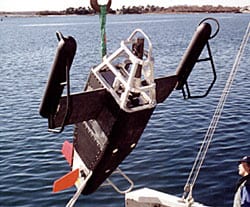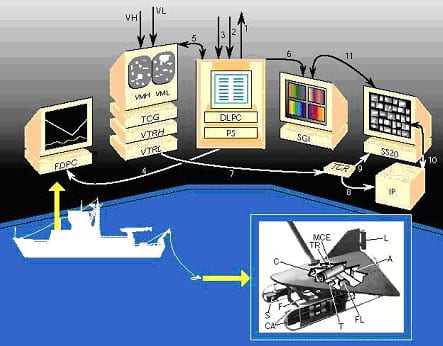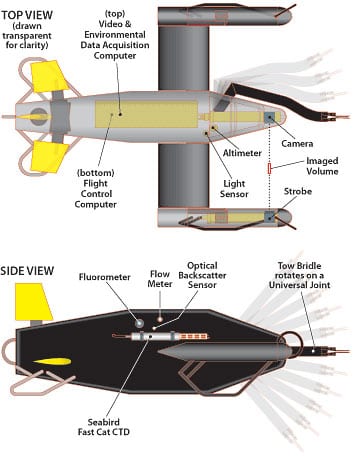Video Plankton Recorder (VPR)
What is it and why do we use it?
The Video Plankton Recorder (VPR) is an underwater video microscope system that takes images of plankton and particulate matter as small as 50 microns and up to a few centimeters in size. The instrument is used to help scientists quickly measure the distributional patterns of plankton without destroying their delicate forms, as can happen when using nets and bottles.
Much of the living matter in the ocean is plankton -- small animals, plants, and microbes that drift passively with currents. Among them are copepods, arguably the most numerous animals on Earth and a critical link in the food chain between primary producers and higher levels, such as fish. Studying plankton helps scientists understand many other things about the ocean, such as changes in fish stocks, pollution, and climate.
How does it work?
The Video Plankton Recorder (VPR) is essentially an underwater microscope. A video camera mounted in one of the arms focuses on a point midway between the two arms. A strobe on the other arm illuminates the imaged volume and flashes 60 times per second, producing 60 images per second of the particles and plankton in the water. The images are then saved internally on a computer hard disk and later plotted.
The instrument is mounted in a frame and lowered into the water from the stern of the ship. Sometimes, a CTD also is mounted next to the VPR to collect depth, temperature, and salinity information at the same time as each video image. The instrument is lowered down through the water to a maximum depth of 350 meters so that we get a profile of plankton/particle abundance and type along with temperature and salinity.
Recently, a fast, 3-axis VPR has been developed for tow speeds up to 12 knots. It can handle autonomous undulation and lateral motion. This fast VPR was used in August 2003 on the R/V Knorrto conduct a continuous, 6,000-km trans-Atlantic survey at 12-knots with undulations every 1 km to a depth of 120m.
What platforms are needed?
It has been used on:
- Towed bodies (V-fin depressor, Seasoar, and the new Fast towfish)
- ROVs (JASON and SeaRover)
- AUVs (REMUS)
- autonomous profiling mooring
Limitations:
- at present, it cannot identify plankton to the species level.
- undersamples rare taxa (e.g., <50/m3).
https://vimeo.com/284029057
A video featuring VPR operations in the western North Atlantic.



